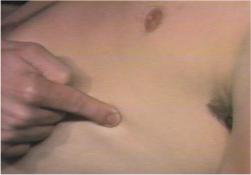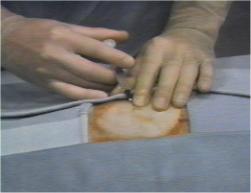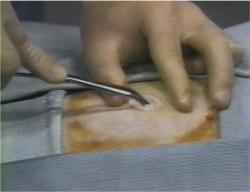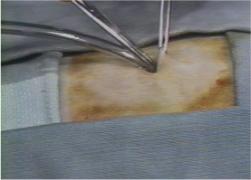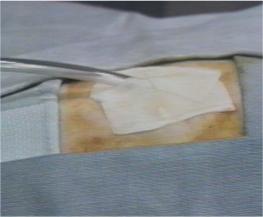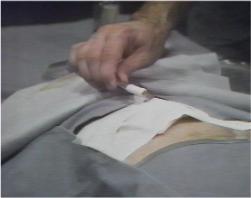|
|
|||||
Insert a Chest TubeFollowing traumatic injury to the chest, blood and air can accumulate, resulting in collapse of the lung. To re-expand the lung, a tube thoracostomy (chest tube) is placed, draining the blood through a one-way valve. The one-way valve allows blood to be expelled during exhaling or coughing, but keeps air or blood from returning during inhalation. Even in the presence of continuing bleeding into the chest, the chest tube will continue to function, keeping the lung exanded and functional. In a hemothorax, the blood will settle in the posterior and inferior aspects of the chest cavity. To effectively drain this blood, insert the chest tube in the 7th intercostal space, in the mid-axillary line.
The chest tube is made of plastic or rubber and has multiple perforations at one end, to prevent clogging. At the other end is a one-way valve. If a standard chest tube is unavailable:
Begin by preparing the skin with antiseptic solution. Sterile technique should be used. If sterile supplies are not immediately available but the need for a chest tube is urgent (life and death), proceed with the insertion, trying to keep things as clean as circumstances will allow. Inject local anesthetic directly over the lower rib and the surrounding and deeper tissues. Make a 1-inch incision directly over the rib and oriented lengthwise along the rib. After you are through the skin and subcutaneous tissues, use a hemostat to spread the tissues apart (oriented in line with the skin incision). Work your way down to the rib, pressing down with the hemostat and spreading the tissues. This may take a minute or two. After you reach the rib, slide the hemostat over the rib and continue pressing down and spreading the tissue.
When you reach the pleural space, you will be able to "pop through" the pleural lining and into the chest cavity with your hemostat. Use the hemostat to spread and enlarge the opening into the chest cavity. Use the same hemostat to grasp the tip of the chest tube and direct it through the opening you have made into the chest cavity. Release the tube from the hemostat and continue to manually insert it further into the chest, directed upward toward the casulty's shoulder.
Suture the skin edges around the tube closed, and use the tail ends of the suture to wrap around the tube, securing it to the skin. Connect the one-way valve to the chest tube. Many people connect the opposite end of the one-way valve to a Foley catheter bag, so that the chest tube drainage can be collected and measured. Place some Vaseline gauze around the chest tube where it enters the skin. This will help seal the chest tube entry site. Cover the Vaseline gauze with dry dressings and then tape everything securely in place.
This section was developed from "Tube Thoracostomy," A1701-73-0517V, Health Sciences Media Division, US Army Medical Department C&S, Fort Sam Houston, Texas. Home · Military Medicine · Sick Call · Basic Exams · Medical Procedures · Lab and X-ray · The Pharmacy · The Library · Equipment · Patient Transport · Medical Force Protection · Operational Safety · Operational Settings · Special Operations · Humanitarian Missions · Instructions/Orders · Other Agencies · Video Gallery · Forms · Web Links · Acknowledgements · Help · Feedback Approved for public release; Distribution is unlimited.
*This web version is provided by The Brookside Associates, LLC. It contains original contents from the official US Navy NAVMED P-5139, but has been reformatted for web access and includes advertising and links that were not present in the original version. The medical information presented was reviewed and felt to be accurate in 2001. Medical knowledge and practice methods may have changed since that time. Some links may no longer be active. This web version has not been approved by the Department of the Navy or the Department of Defense. The presence of any advertising on these pages does not constitute an endorsement of that product or service by either the US Department of Defense or the Brookside Associates. The Brookside Associates is a private organization, not affiliated with the United States Department of Defense.
© 2015, Brookside Associates, LLC. All rights reserved |
|
||||


